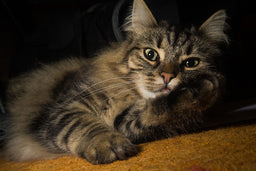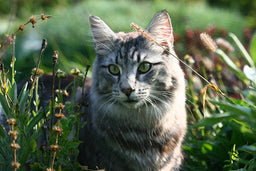British Shorthair grooming—the ultimate guide
Since British Shorthairs don’t have a long coat, they don't require a lengthy and complex grooming routine. Even so, some basic care is necessary if you want your kitty to keep that soft and gorgeous fur that makes them look like a plush toy. More importantly, it's a protective barrier that keeps their skin safe from the hazards of the outside world, so taking proper care of it is crucial for your furry friend’s well-being.
Untamed offers some handy British Shorthair grooming tips and diet recommendations to keep your kitty gorgeous, healthy, and happy.
Why is it necessary to groom your British Shorthair?

If you don’t groom me, I will have to do it myself.
Source: Pixabay
Regular grooming makes your British Shorthair look pretty, but it also keeps them healthy. Grooming sessions allow you to check your kitty for possible injuries, health issues, and parasite infestations.
Although their fur won't mat, British Shorthairs also need regular brushing. If you fail to do it, your kitty will ingest the dead hair while cleaning themselves, which leads to annoying hairballs. Besides removing dead hair, brushing helps distribute natural oils over the coat, making it soft and shiny.
How to look after your British Shorthair's fur
When it comes to beauty treatments for your British Shorthair, it is necessary to distinguish between:
- Cleaning
- Grooming
Cleaning your British Shorthair
Felines have naturally oily fur, but if you feel like you need to wash your hands every time you touch your cat, it's time for a good old cleaning session.
Cleaning your British Shorthair includes more than brushing. To keep your cat's hygiene at a high level and avoid infections, you should include the following in your cleaning rituals:
- Bathing
- Teeth cleaning
- Eye cleaning
- Ear cleaning
Bathing your British Shorthair
If I manage to blend in the background, you may not notice me, and I will have successfully avoided bath time.
Source: Alina Vilchenko
It's advisable to bathe your British Shorthair once a month or every six weeks. If you do it more frequently, you risk removing the natural oils, which will make your kitty’s coat look dry. It's crucial not to skimp on the shampoo you use, so make sure you always pick high-quality products that contain essential oils. It's also important to start bathing your British Shorthair from kittenhood so that they get used to the water from an early age.
Once you are ready to give your kitty a good bath, here is what to do:
- Wet your feline with room temperature water
- Mix one part shampoo with five parts water
- Apply on your cat and massage gently, avoiding the areas around their eyes, nose, and ears
- Rinse off thoroughly
- Pat your cat dry with a towel or use a hairdryer
Cleaning your British Shorthair's teeth
Food buildup on your cat's teeth can cause more health issues than gum problems and teeth loss. If you neglect your British Shorthair's dental hygiene, oral bacteria can spread to your feline's heart, liver, or kidneys.
For this reason, you should be able to notice some common signs that your feline is suffering from a dental problem, such as:
- Bad breath
- Loose and discoloured teeth
- Inflamed or bleeding gums
Any of these symptoms is a sign you should schedule a vet visit.
Brushing your cat's teeth using a special vet-approved brush and a cat-safe toothpaste as often as possible—ideally, twice a week—is a must. If your kitty dislikes the toothbrush, you can take care of their teeth by cleaning them with a piece of gauze wrapped around your finger.
You should also feed your British Shorthair high-quality dental food, as it can considerably improve their oral health. Although wet food is the best choice for felines because of the higher protein and moisture content, some vets recommend feeding small quantities of dry food from time to time since kibble can help remove buildup from teeth.
Cleaning your British Shorthair's eyes
Despite their slightly brachiocephalic head shape, British Shorthairs don't suffer from any inherent or chronic eye problems, but it’s still necessary to clean their eyes from time to time. You can do it using a cotton ball dipped in clean water or a cleaning solution, such as hydrogen peroxide. Gently wipe the corners of your kitty's eyes to remove the goo and clean the area around the eyes too.
Cleaning your British Shorthair's ears

If I lay here… If I lay here, would you leave me alone and forget the comb?
Source: Juwelia
Ear mites can cause much more severe problems than discomfort and urge for aggressive scratching, including an infection of the outer ear. If left untreated, they can spread to the middle and inner ear, damaging the eardrum and permanently affecting your cat's hearing and balance. For this reason, you need to clean your British Shorthair's ears regularly. Here’s what the procedure should look like:
- Dip a piece of gauze in a cleaning solution
- Clean your cat's ears by gently wiping the inside of their ears
- Drip a few drops of a cleaning solution in both ears
- Massage the cat's ears using circular motions to get the dirt to come out
- Wipe everything with a clean and dry gauze
Grooming your British Shorthair
Grooming your British Shorthair involves:
- Brushing
- Nail trimming
Brushing your British Shorthair
Unlike bathing and cleaning, you need to brush your feline more frequently—ideally once or twice a week or more often during the moulting season.
Besides keeping your feline's fur beautiful and preventing uncomfortable hairballs, regular brushing also helps reduce shedding. Since British Shorthairs generally don't shed too much unless there is an underlying health problem, they are one of the favourite breeds among cat allergy sufferers. Brushing them will make sure you feel the allergy symptoms even less.
Before brushing your British Shorthair's fur with a comb or a brush, you may want to dampen your hands and gently massage your feline. This step is a good idea because you will feel if your cat has a rash or any other skin problem or parasitic infestation. Once you do it, follow these tips:
- Always brush in the direction of hair growth—Although British Shorthairs are laid-back and will wait patiently even if you "rub them the wrong way," going against the hair growth is a lot less pleasant for them
- Brush all of their coat, even the tummy area—British Shorthairs love a good belly rub, so they likely won't mind it, but give them a break if you notice they are starting to feel uncomfortable
- Snip away matted or dirty fur under the tail—Looking under your kitty's tail may not be the most respectful thing to do, but it will allow you to notice problems, such as:
- Tapeworm eggs
- Irritation
- Discharge or bleeding
Trimming your British Shorthair's claws

You can hope, but I will never get used to nail cutting.
Source: Omar Ramadan
Even if you provide a suitable scratching post, preventing your British Shorthair from having a manicure treatment on your sofa, it may not be enough to keep their nails short and less sharp. Clipping your kitty’s claws is not the most pleasant experience for anyone involved, but your furry friend will get used to it if you start practising at an early age.
Adequate tools will help you do this quickly and easily. Refer to the table below to see what you need and how to use it:
|
Tool |
What to do |
|
Clippers |
Clip only the tips of your kitty’s nails, paying attention not to damage the nerve endings. If your British Shorthair’s claws are white, you will easily see how much you can cut. If they are black, you will need to be extra careful. If you can see that a bit of the nail looks yellowish and old, that’s the part to clip off |
|
Grinder |
If you are not comfortable using clippers, you can trim your kitty’s nails with a grinder. The risk of hurting your cat will be minimal. What you need to do is gently press your feline’s paw to expose the nails and grind until you are happy with the length |
|
File |
A file is much softer and gentler than a grinder, allowing you more control over how much you file. The downside of using this tool is that it takes more time than the previous two methods. The best way to go is to cut your kitty’s nails with clippers and use a file to smooth the nail |
What if your British Shorthair sheds more than usual?
British Shorthairs don't shed as much as many other breeds. If you notice that they are losing more hair than usual—and it's not due to weather changes—it's a sign that something is wrong.
The most common reasons for increased shedding or unusual hair loss include:
- Exposure to stress—If your kitty suffers from anxiety or is chronically stressed, they may start overgrooming. The cause of stress could be:
- Lack of attention
- New family member
- Other pets
- Lack of cognitive stimulation
- Change of environment
- Allergies—Hair loss can be a consequence of an allergic reaction. The most common allergens are:
- Ingredients in food (dairy, even lactose-free milk, eggs, grains, food colourants, taste enhancers)
- Flea bites
- Household chemicals
- Health issues—Many illnesses or parasites can cause excessive shedding or hair loss, including:
- Ringworm
- Hyperthyroidism
- Dermatitis
- Fungal or bacterial infections
- Kidney disease
- Liver issues
- Inadequate diet—Improper diet is the most common cause of excessive shedding and poor coat quality. Besides skin and coat problems, food rich in grains, carbs, sugar, and other filler ingredients can lead to obesity, diabetes, heart disease, and many other problems
What's the best diet to keep your British Shorthair's coat pretty?

Meat and fish—that’s what your cat needs.
Image (c) Untamed
The best diet for your feline is the one that resembles their natural eating habits. In the wild, cats hunt small animals, such as mice, birds, slugs, moths, and similar. Domesticated cats will do just fine with suitable portions of high-quality meat and fish-based meals. A well-balanced feline diet that meets all their nutritional needs keeps their coat beautiful and prevents diet-related health problems should contain appropriate quantities of:
- Animal protein—Meat and fish are the most critical ingredients in cat food because they are the main source of energy for cats and the only source of essential amino acids, such as taurine, that felines need to stay healthy. The food you choose should contain at least 50% of animal protein. You should avoid meals that contain grains and vegetable protein because they are a common cause of digestive issues, such as diarrhoea and vomiting
- Animal fat—Fat found in high-quality jelly or gravy meals is a source of fatty acids necessary for healthy skin and coat, cell integrity, and efficient immune response. It also ensures excellent taste and texture that felines can't resist
- Vitamins and minerals—Cats get all of their vitamins and minerals from meat. These micronutrients are crucial for practically all biological functions
How Untamed can help keep your British Shorthair’s fur gorgeous

Untamed can make your British Shorthair’s coat softer and prettier than ever!
Image (c) Untamed
Keeping your British Shorthair's fur and overall health in great shape is super easy with Untamed.
All Untamed meals are:
- High in protein—Our recipes contain twice as much protein as most commercially sold products
- Free from known allergens—We also offer single protein meals—Tuck-In Tuna in Jelly and Chocka Chicken in Jelly—for super sensitive kitties
- Formulated by vets—Our dishes are grain-free, sugar-free, and low-carb—all your cat needs to be healthy and happy, whether they are kittens, adults, seniors, neutered, pregnant, lazy, active, too skinny or too plump
- Ethically produced—We only collaborate with cruelty-free and sustainable suppliers, our packaging is fully recyclable, and our supply chain is carbon neutral
Depending on your cat's preferences, you can choose dishes made with:
- Chicken breast and liver
- Duck
- Tuna steak
- Sardine fillet
- Mackerel fillet
- Salmon fillet
- Shrimp
We don't compromise on taste, so even the fussiest of felines won't turn their noses up at our tins.
Treat your British Shorthair to the best food—order Untamed now!
How to order delicious Untamed meals
A tailor-made meal plan can land on your doorstep in a day! All you need to do is:
- Complete our Try Now quiz
- Pick the products your cat may like
- Place your order
When your British Shorthair tries out the trial pack and gives us a meow of approval, we can deliver a selection of your kitty's favourite dishes to you every month. As many satisfied cat parents whose furry friends have switched to Untamed say, you can expect:
|
Timeline |
What to expect |
|
After a week |
|
|
After two months |
|
|
Within four months |
|
|




